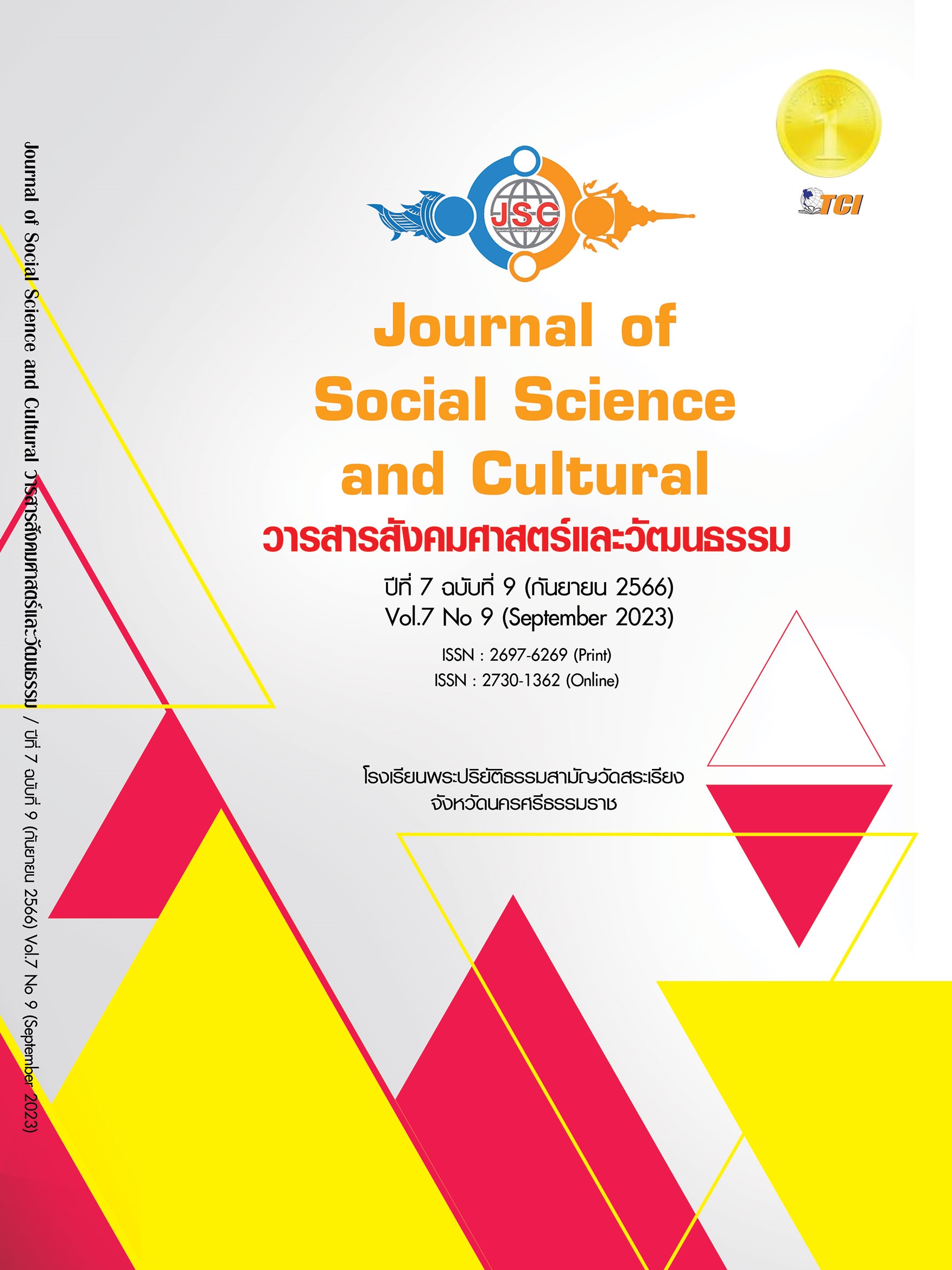INTERIOR ENVIRONMENT IN THAI STYLE MOSQUE
Main Article Content
Abstract
The article “Interior Environment in Thai Style Mosque” aims to study information related to the design of the interior physical environment of a mosque that is influenced by Thai style design concepts that can be physically preceived. It is a guideline for studying and developing the design of interior environments in buildings that are similar or related. Topics of the study include: 1) Mosque: origin and meaning, 2) Elements of the environment within the mosque, 3) Architectural concepts of mosques in Thailand, 4) Mosque decoration and the influence of the design of Thai art patterns and Islamic art styles, and 5) a mosque that has a Thai-style physical environment, which develops the concept of architectural design of mosques in Thailand Influenced by Islamic religious factors, Influenced by local factors and influences from the world situation and the affecting the construction of mosques in Bangkok. Including the influence of pattern design, Thai art styles and Islamic art styles. Affecting the concept of mosque architecture during the time that the mosque was built according to the traditional Thai architectural style (before 1851) can be studied from the case study of Bang Luang Mosque. (Kudikhao Mosque) and Tonson Mosque (Kudi Luang Mosque). Therefore, from the study of "Thai Interior Environment Style in a Mosque" especially mosques that have been influenced by traditional Thai architectural style concepts that can be physically perceived according to the elements of the interior environment that include needed space by the user belong activities in the functional area, creating enclosures for various areas, environmental system within the building, designing furniture and facilities, including beauty with decorative part, which is part of the guideline for continuous research and developed to be applied as a guideline for being built interior environment in buildings that have similar characteristics or are appropriately related.
Article Details
References
กฎกระทรวง (ฉบับที่ 55). (2543). พระราชบัญญัติควบคุมอาคาร พ.ศ. 2522. ราชกิจจานุเบกษา เล่ม 117 ตอนที่ 75 ก (7 สิงหาคม 2543).
คณะกรรมการอิสลามประจำจังหวัดชลบุรี. (2556). หยุดคิดสักนิดก่อนสร้างมัสยิดหลังใหม่. เรียกใช้เมื่อ 17 กรกฎาคม 2566 จาก http:// www.picoc.or.th/article/detail/15/10
เจนจิรา เบญจพงศ์. (2549). ลวดลายประดับแบบอิสลามในศิลปะไทย (พุทธศตวรรษที่ 21-23). ใน วิทยานิพนธ์ศิลปศาสตรมหาบัณฑิต สาขาวิชาประวัติศาสตร์ศิลปะ. มหาวิทยาลัยศิลปากร.
ชนสรณ์ บุญจำนงค์. (2559). Asaconservationaward-มัสยิดบางหลวง. เรียกใช้เมื่อ 15 กรกฎาคม 2566 จาก http://asaconservationaward.com/index.php/2016-06-13-15-22-21/temple2554/224-bang-luang-mosque
ผู้จัดการรายวัน. (2547). มัสยิดบางหลวง มัสยิดทรงไทย ศิลปะ 3 ชาติ หนึ่งเดียวในโลก. เรียกใช้เมื่อ 7 กรกฎาคม 2566 จาก http://www.manager.co.th/Daily/ViewNews.aspx?NewsID=9470000019006
มักศูเราะฮ์-วิกิพีเดีย. (2565). มักศูเราะห์. เรียกใช้เมื่อ 7 กรกฎาคม 2566 จาก https.//th.wikipedia.org/wiki/มักศูเราะฮ์
วสมน สาณะเสน. (2557). แนวคิด รูปแบบและพัฒนาการของมิหร็อบของมัสยิดต้นสน เขตบางกอกใหญ่ กรุงเทพมหานคร. ใน วิทยานิพนธ์ศิลปมหาบัณฑิต สาขาวิชาทฤษฎีศิลป์. มหาวิทยาลัยศิลปากร.
ศักดา เซะวิเศษ. (2565). ละหมาด: หลักปฏิบัติในมิติคำสอนอิสลามกับการบูรณาการแนวปฏิบัติในสถานการณ์วิกฤตโควิด 19. เรียกใช้เมื่อ 12 กรกฎาคม 2566 จาก http://www.culture.bsru.ac.th/wp-content/uploads /2022/12/08ทีทัศน์-21-ฉ2-ปี65-ละหมาดหลักปฏิบัติในมิติคำสอนอิสลาม.pdf
เสาวนีย์ จิตต์หมวด. (2527). หน้าที่ของมัสยิดต่อสังคมมุสลิมในภาคกลาง. ใน วิทยานิพนธ์สังคมวิทยามหาบัณฑิต ภาควิชาสังคมวิทยาและมานุษยวิทยา. จุฬาลงกรณ์มหาวิทยาลัย.
อาดิศร์ อิดรีส รักษมณี. (2552). แนวคิดที่เกี่ยวข้องกับสถาปัตยกรรมมัสยิดในกรุงเทพฯ. ใน วิทยานิพนธ์สถาปัตยกรรมศาสตรดุษฎีบัณฑิต สาขาวิชาสถาปัตยกรรม. จุฬาลงกรณ์มหาวิทยาลัย.
Kahera, A., et al. (2009). Design Criteria for Mosques and Islamic Centers Art, Architecture and Worship. United Kingdom: Elsevier Ltd.
Kuran, A. (1986). The Mosque in Early Ottoman Architecture. United State of America: University of Chicago.
Wikipedia-Dikka. (2022). Dikka. Retrieved กรกฎาคม 7 , 2566, from https://en.wikipedia.org/wiki/Dikka


